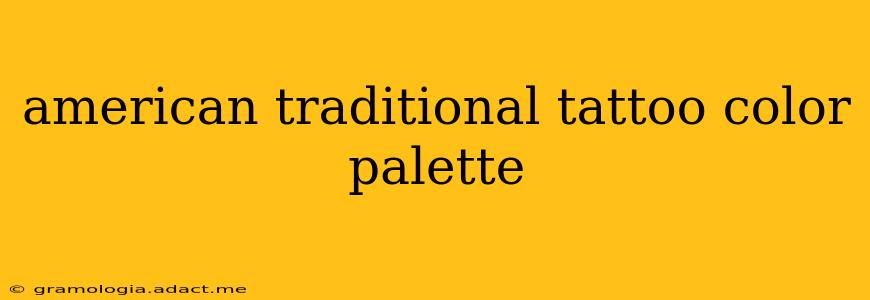American Traditional tattoos, with their bold lines and vibrant colors, hold a special place in tattoo history. This style, born in the early 20th century, relies heavily on a specific and iconic color palette. Understanding this palette is key to appreciating the artistry and appreciating the enduring appeal of these timeless designs. This article delves deep into the classic inks used, exploring their historical context and modern interpretations.
What are the Primary Colors in American Traditional Tattoos?
The core of the American Traditional palette is surprisingly limited, focusing on bold, saturated hues that stand the test of time. The primary colors are:
-
Red: A deep, rich crimson red is a staple. Think less fire-engine red and more of a blood-red or ruby tone. Its use often represents passion, courage, or even bloodshed, depending on the subject matter.
-
Yellow: A strong, almost mustard yellow is frequently used. It provides a strong contrast against the other colors and adds vibrancy to the piece. It often represents sunshine, joy, or even warning.
-
Blue: Typically a deep cobalt or Prussian blue, offering a striking counterpoint to the warmer tones. This shade adds depth and contrast, contributing to the overall boldness of the design. It often represents loyalty, tranquility, or even sadness.
-
Green: A slightly muted, almost emerald green is common. It complements the other colors well and allows for a wider range of shading and depth. Often used for foliage, snakes, or other nature-inspired elements.
What Other Colors are Commonly Used?
While the above form the backbone, other colors enhance the palette:
-
Black: The essential outlining and shading color. Its quality and application are paramount to the success of an American Traditional tattoo.
-
White: Used sparingly, for highlights and details, creating sharp contrast and adding luminosity.
Are there Variations in the American Traditional Color Palette?
While the core remains consistent, subtle variations exist based on the artist's style, the age of the tattoo, and the availability of inks. Some artists might opt for slightly more vibrant or muted tones, creating a unique spin on the classic palette. The aging process of the tattoo itself also alters the colors, contributing to its unique character.
What about shading and color blending?
Shading in American Traditional tattoos typically uses black and grey washes to add depth and dimension to the images. Color blending is less common, with colors usually appearing as bold blocks of saturated hues.
How has the color palette evolved over time?
The color palette has remained remarkably consistent since its origins. However, modern artists sometimes experiment with slightly bolder or more nuanced variations of the classic colors, while still adhering to the spirit of the style.
Why is this palette so effective?
The effectiveness of the American Traditional color palette stems from its simplicity and boldness. The limited color range creates strong visual impact and allows each color to stand out, resulting in designs that are immediately recognizable and enduring. The colors were also chosen for their longevity and resistance to fading, ensuring the tattoos would age gracefully.
Conclusion:
The American Traditional tattoo color palette is more than just a collection of inks; it's a fundamental element of the style's identity. By understanding the core colors, their variations, and their historical significance, we can better appreciate the artistry and enduring legacy of these classic tattoos. The boldness, simplicity, and lasting power of this palette continue to inspire tattoo artists today, ensuring its place in tattooing history for years to come.
